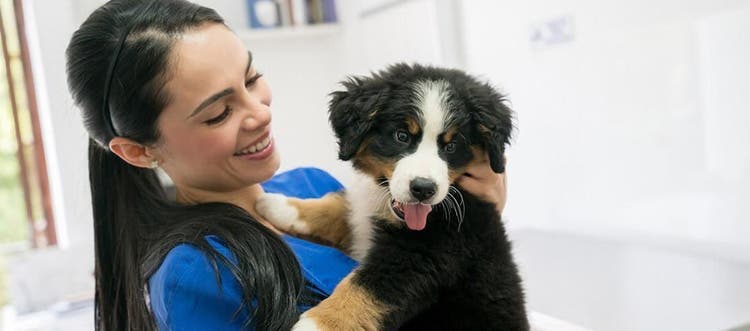Think you know worms? Get the facts about intestinal worms in your dog or cat.
Worms are common parasites in cats and dogs, but how much do you really know about them? These common myths and corresponding facts will help you understand intestinal worms in dogs and cats, the dangers they pose, the signs to look out for, and how to keep your pet and family protected.
Myth: My indoor pets can’t get worms.
Fact: Your dog or cat can catch worms anywhere – even if they spend most of their time indoors.
- Pets can catch worms anywhere – from paddocks and parks to backyards and beaches. Worms are carried by wildlife, farm animals and insects. They sometimes even turn up in undercooked meat.
- Puppies can become infected with roundworm while in the womb. Both puppies and kittens can be infected with worms through their mother’s milk when suckling.
- Fleas infected with tapeworm larvae can infect dogs and cats that aren’t on adequate flea control. Whilst grooming, it is very easy for pets to ingest these tapeworm infected fleas.
- Pets can be infected when they accidentally swallow microscopic worm eggs or larvae (e.g. while grooming or playing with a toy).
- Some worms, such as hookworm, can infect pets by larvae penetrating their skin, especially through their paws.
- Heartworm can be transmitted to dogs and cats when they are bitten by mosquitoes carrying heartworm larvae.
- Pets that hunt and eat animals, including lizards, mice and birds, or scavenge animal carcasses, are at higher risk of many intestinal worms. Any critters, including cockroaches, that venture indoors can potentially infect your pet with worms.
Myth: Most worms reproduce slowly and have a complicated life cycle.
Fact: Some worms can produce 200,000 eggs per day within 3-4 weeks of infection.
- Worm eggs can survive in the environment and remain infectious for several years.
- Worms in your pet can build up quickly and make them feel quite sick. Some can even be deadly.
- The signs of infection are not always obvious. Some pets don’t show signs of sickness when carrying worms but will contaminate their environment with worm eggs in their faeces, putting other animals and humans at risk of disease.
Myth: Only dogs and cats can get worms – not people.
Fact: Worm infestations in your pet can threaten the health of you and your family.
- Children are most at risk of getting worms from a cat or dog, as they’re often in closest contact with family pets, and often forget to wash their hands after playing with them. They also tend to spend a lot of time outside and can pick up worm eggs from contaminated soil.
- The spread of worms from pets to people can be prevented by taking the following steps:
- Make sure everyone washes their hands after touching their pet and before eating.
- Cover sandpits to prevent animals from defecating in them.
- Clean up your pet’s poo from the yard daily.
- Treat all pets regularly with an intestinal dewormer.
Myth: Heartworms are rarely fatal in dogs.
Fact: Heartworms can kill.
- Deadly heartworm is transmitted to your dog via infected mosquitoes.
- Unlike other worms, adult heartworms can live in the heart and surrounding blood vessels for up to seven years – growing up to 30 cm in length.
- Symptoms of heartworm in dogs include coughing, weakness, decreased appetite, shortness of breath, swollen abdomen, fainting, fatigue, and occasionally sudden death.
Myth: Cats do not need heartworm protection.
Fact: Heartworms can infect both dogs and cats.
- Cats can become infected with heartworm, and unfortunately it is difficult, costly and takes a long time to treat. Therefore, prevention is essential.
- Symptoms of heartworm in cats may include weakness, difficulty breathing, coughing and wheezing, vomiting, anaemia, and sometimes sudden death. However, some infected cats show no signs at all.
- Heartworm infection in cats can be fatal.
Myth: Lungworms rarely infect cats and aren’t that dangerous.
Fact: Lungworms can be dangerous for cats.
- Lungworm infection can cause serious health problems in cats and can be fatal.
- Cats can become infected after eating snails, slugs, rodents, birds or reptiles that carry the lungworm parasite.
- Lungworms damage the lungs, causing breathing difficulties, coughing, wheezing, weight loss and lethargy.
- Some cats show no symptoms, or only mild symptoms that can be mistaken for hairballs or feline asthma.
Myth: Oesophageal worms are rare in Australia and aren’t that dangerous
Fact: A significant number of cases of oesophageal worm have been detected in Australia, and they pose a serious health risk to dogs
- While initially thought to be rare in Australia, the oesophageal worm appears to be more common than expected. Since 2020, more than 300 cases have been diagnosed in a single vet clinic in QLD alone.
- Dogs become infected after eating dung beetles, birds, reptiles, rodents or frogs. These worms can grow up to 8 cm long and live for up to 2 years in the wall of the oesophagus (food pipe).
- The oesophageal worm can cause serious disease in dogs. Worms can cause nodules to form in the wall of the oesophagus – these nodules can become cancerous and spread to other areas of the body.
- Dogs can show a variety of symptoms including difficulty swallowing, vomiting, drooling, weight loss, coughing, difficulty breathing and sometimes sudden death.
- Some dogs show no symptoms or only mild symptoms.
Myth: It’s quite difficult to prevent worm infections in dogs and cats.
Fact: You can keep worms at bay by taking the following steps.
- Clean kennels and your pet’s bedding regularly.
- Clean up your pet’s poo from the yard and empty cat litter trays daily. Cover sandpits that are not in use.
- Avoid feeding your pet raw meat or offal.
- Prevent pets from hunting & scavenging.
- Provide sufficient high-quality food and plenty of alternative activities to fill in their day to reduce your pet’s drive to hunt.
- Always wash your hands thoroughly after playing with your pet and before eating.
- Regularly use a parasite prevention product such as Advocate™ or Milbemax™
AdvocateTM is a water resistant, easy to apply monthly spot-on that protects dogs and cats against heartworm, most intestinal worms and fleas. In addition, it also protects dogs against the oesophageal worm and cats against lungworms. Advocate is unique, as it provides ongoing protection from new worm infestations between treatments, meaning less eggs are shed into the environment and thereby reducing the risk of disease to people and pets.
MilbemaxTM comes in an easy to give tablet formulation that protects dogs and cats against major gastrointestinal worms when given once every 3 months. If Milbemax is given monthly, it will also provide protection against deadly heartworm.
Always read and follow label directions.

Advocate for dogs
Advocate provides fast relief from fleas, prevents deadly heartworm and helps protect your dog and your family from most intestinal worms

Milbemax™ worming tablets for dogs
Milbemax™ tablets for dogs protect against all the most common worms your dog will come into contact with, including tapeworm.




